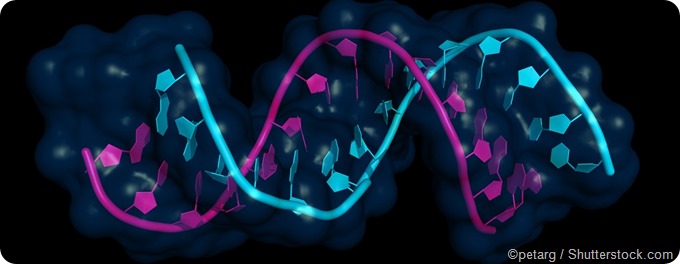An interview with Professor Matthew Disney conducted by April Cashin-Garbutt, MA (Cantab)
What are RNA repeats and how many diseases are they known to cause?
RNA repeats are stretches of code in the body that incrementally repeat. For example, in the most common cause of adult-on-set muscular dystrophy a RNA has a repeat of r(CUG) and this three letter code can repeat thousands of times.
There are greater than 30 diseases that are caused by RNA repeats and no have a cure. That is why we are studying them to help understand how they causes disease but to also provide a treatment.

Can you please outline your investigation into developing drug candidates for spinocerebellar ataxia type 10 (SCA10)?
SCA10 is an incurable and rare neuromuscular disease that is caused by a repeat of r(AUUCU). When this RNA folds into a structure that has this repeat it forms AU base pairs.
At one time we were investigating what types of small molecule bound AU base pairs selectively. Once we identified these molecules, we customized them for targeting the AU base pairs in r(AUUCU). Gratifyingly these compounds bound these repeats strongly and selectively and reversed disease-associated defects in cells.
What were the main challenges in identifying small molecules that targeted the RNA base pairs precisely?
The main challenge was that not much was known about small molecules targeting RNA in general but especially compounds that target base pairs. So, we had to set up to assess to figure out if compounds bound to these pairs.
We also had to construct a library of small molecules that looked like they could bind to these targets.
How did you leverage this information to design drug candidates?
Once we found small molecules that bound to AU pairs in RNA repeats of r(AUUCU), we used the repetitive nature of the repeat to allow for the design of a small molecule that would selectively target a repeat. Thus, we made compounds that mimicked the repeat of the structure of r(AUUCU).
How successful was the new drug candidate at targeting the RNA repeats?
When we add a low amount of the compound to cells, 50 nM, the molecule is capable of reversing a cell death phenotype back to what is observed if the repeat is not there. So we were very successful at targeting the repeat in cells but there is much work to be done including targeting in an animal.
Do you think this technique could be used to develop other compounds that target different RNAs?
Yes, in fact, one of the motivations we had for identifying compounds that target base pairs was that we have been working for year on finding compounds that target non-based paired regions in RNA and have been quite successful. Thus, we want to make hybrid compounds that could be designed to target any folded RNA.
What do you think the future holds for targeting RNA repeats?
Well the ultimate goal of these studies is to get a compound into a patient to affect the disease. The future is just that – using this information to not treat cells but to test their therapeutic utility in a patient that has no cure.
Where can readers find more information?
Our lab’s website - DisneyLaboratory.com
About Professor Matthew Disney
 Matthew Disney, a native of Baltimore, Maryland, received his early schooling in the Baltimore Catholic School System, his B.S. from the University of Maryland, College Park, and his Ph.D. at the University of Rochester.
Matthew Disney, a native of Baltimore, Maryland, received his early schooling in the Baltimore Catholic School System, his B.S. from the University of Maryland, College Park, and his Ph.D. at the University of Rochester.
He began his independent career in 2005 and moved to the Department of Chemistry at The Scripps Research Institute in 2010, where he is currently Professor. He is a pioneer in the development of precision medicines. His laboratory is focused on understanding RNA-ligand interactions, and using this information to rationally design small molecules that modulate RNA function or toxicity from only sequence.
His laboratory has recently reported success targeting RNA repeat expansions that cause incurable genetic disorders, including myotonic muscular dystrophy type 1, Huntington’s disease, and amyotrophic lateral sclerosis, in cellular and animal models of disease as well as various RNAs involved in causing incurable forms of cancer.
Matt has received various awards including the NIH Director’s Pioneer Award, Blavatnik Young Investigator Award in Chemistry Finalist, The Tetrahedron Young Investigator Award, Camille & Henry Dreyfus New Faculty Award, The Camille & Henry Dreyfus Teacher-Scholar Award, the Research Corporation Cottrell Scholar Award, the Eli Lily Award in Biological Chemistry, the David W. Robertson Award for Excellence in Medicinal Chemistry, and the David Y. Gin New Investigator Award from the American Chemical Society.